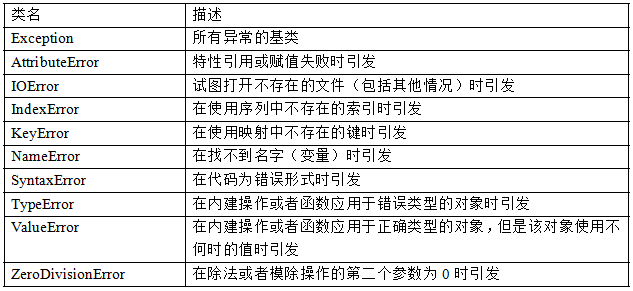0910--https://www.cnblogs.com/fnng/archive/2013/04/28/3048356.html
Python异常
Python用异常对象(exception object)来表示异常情况。遇到错误后。会引发异常。如果异常对象未被处理或捕捉,程序就会用所谓的回溯(Traceback,一种错误信息)终止执行:
>>> 1/0 Traceback (most recent call last): File "<pyshell#0>", line 1, in <module> 1/0 ZeroDivisionError: division by zero
raise语句
为了引发异常,可以使用一个类(Exception的子类)或者实例参数调用raise语句。下面的例子使用内建的Exception异常类:
>>> raise Exception('hyperdrive overload') Traceback (most recent call last): File "<pyshell#2>", line 1, in <module> raise Exception('hyperdrive overload') Exception: hyperdrive overload
系统自带的内建异常类:

自定义异常
尽管内建的异常已经包括了大部分的情况,而且对于很多要求都已经足够了,但有些时候还是需要创建自己的异常类。
和其他类一样,只是要确保从Exception类继承,不管是直接继承还是间接继承。像下面这样:
>>> class someCustomException(Exception):pass
捕捉异常
使用try/except来实现异常的捕捉处理。
假设创建了一个让用户输入两个数,然后进行相除的程序:
try: x = int(input('Enter the first number:')) y = int(input('Enter the sencond number:')) z = x/y print(z) except ZeroDivisionError: print('输入的数字不能为0!') #输入 Enter the first number:1 Enter the sencond number:0 输入的数字不能为0!
假如,我们再调试的时候引发异常会好些,如果在与用户的进行交互的过程中又是不希望用户看到异常信息的。如何开启/关闭“屏蔽”机制?
class MuffledCalulator: muffled = False #这里默认关闭屏蔽 def calc(self,expr): try: return eval(expr) except ZeroDivisionError: if self.muffled: print ('Division by zero is illegal') else: raise #运行程序: >>> calculator = MuffledCalulator() >>> calculator.calc('10/2') 5 >>> calculator.clac('10/0') Traceback (most recent call last): File "<pyshell#30>", line 1, in <module> calculator.clac('10/0') AttributeError: MuffledCalulator instance has no attribute 'clac' #异常信息被输出了 >>> calculator.muffled = True #现在打开屏蔽 >>> calculator.calc('10/0') Divsion by zero is illagal
多个except子句
如果运行输入两个数,求除法程序,输入非数字的内容,还会产生另外一个异常:
try: x = int(input('Enter the first number:')) y = int(input('Enter the sencond number:')) z = x/y print(z) except ZeroDivisionError: print('输入的数字不能为0!') except ValueError: print('请输入数字') #运行程序 Enter the first number: 10 Enter the second number: 'hello,word' 请输入数字!
一个块获取多个异常
try: x = int(input('Enter the first number:')) y = int(input('Enter the second number:')) print(x/y) except (ZeroDivisionError,TypeError,NameError,ValueError): print("输入的内容有误,请输入非0数字!") #运行程序 Enter the first number:1 Enter the second number:0 输入的内容有误,请输入非0数字! #输入非数字 Enter the first number:a 输入的内容有误,请输入非0数字!
捕捉全部异常
就算以上处理了好几种异常,总有不小心忽略处理的情况,如果真想用一段代码捕捉所有异常,那么可在except子句中忽略所有的异常类:
try: x = int(input('Enter the first number:')) y = int(input('Enter the second number:')) print (x/y) except: print ('Sorry,Please enter again!') #运行程序 Enter the first number:1 Enter the second number:djfjshfjkd Sorry,Please enter again!
加入循环,若用户输入了错误信息,允许重新输入
while True: try: x = int(input('Enter the first number:')) y = int(input('Enter the second number:')) value = x/y print ('x/y is',value) break except: print ('输入的内容无效,请重新输入!') #执行程序 Enter the first number:a 输入的内容无效,请重新输入! Enter the first number: 输入的内容无效,请重新输入! Enter the first number:1 Enter the second number:0 输入的内容无效,请重新输入! Enter the first number:1 Enter the second number:3 x/y is 0.3333333333333333